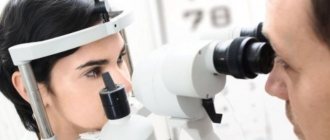Every year the number of people who experience myopia and other eye diseases is growing rapidly. Many pregnant women experience various pathologies of the visual apparatus.
Is it possible to give birth on your own if you have poor vision? This question is asked by expectant mothers who heard an unpleasant diagnosis during a consultation with an ophthalmologist.
With what vision can you not give birth yourself? Why is myopia dangerous during pregnancy? How to avoid negative consequences during the perinatal period in the presence of pathologies of the visual apparatus? Let's look at this information later in the article.
What it is
In ophthalmology, “myopia” is understood as a pathology in which a person cannot clearly see distant objects.
This is due to the fact that the image is focused in the plane in front of the retina. As a result, the picture becomes blurry and does not have clear outlines.
The second name for this disease is myopia. It occurs against the background of a discrepancy between the length of the optical system of the eye and its strength.
Types of myopia:
- axial – occurs when the size of the eyeball increases;
- refractive – excessive force of the refractive apparatus.
According to the degree of manifestation, myopia is:
- weak;
- average;
- high.
Weak myopia and moderate myopia during pregnancy do not have a negative impact on the process of childbirth.
High myopia during pregnancy can cause even more severe vision loss.
Myopia can be either congenital or acquired.
For what vision is Caesarean section prescribed?
If a woman has reduced visual acuity, a cesarean section is not prescribed in all cases. Myopia (myopia, when a person sees well up close, but poorly at a distance) can have 3 stages:
- low (up to minus 3 diopters);
- average (from minus 3 to minus 6 diopters);
- high (from minus 6 diopters and above).
With a low degree of myopia, a cesarean section is never prescribed unless there are other indications for it. It is used if a woman has a moderate or high degree. Even with an average degree of decrease in visual acuity, a cesarean section is not always recommended. To do this, there must be an additional risk of retinal detachment or rupture.
Influence
Expectant mothers who have been diagnosed with pathologies of the visual apparatus are worried about the impact of the birth process on vision.
As a rule, the presence of myopia is a direct contraindication to natural delivery. However, this assumption is not unambiguous and categorical.
To determine which births are available to a woman with poor vision, it is necessary to analyze the overall clinical picture of her health. It is based on the following criteria:
- condition of the retina;
- general physical condition of the woman;
- fundus condition;
- age of the pregnant woman;
- existing visual acuity;
- the presence of other pregnancy complications.
Only on the basis of all the data can the doctor make the correct conclusion about the method of delivery.
Correct behavior during the period of pushing and following medical recommendations significantly reduce the risk of complications.
How to keep your eyes healthy
Of course, the state of health depends not only on doctors, but also on the expectant mother. Pregnancy always puts increased strain, including on the eyes. Therefore, while waiting for a child, it is especially important to maintain visual hygiene:
- do eye exercises;
- avoid prolonged eye strain, take breaks when working at the computer and other gadgets;
- if necessary, correct vision with glasses;
- do not read in poor lighting or in public transport;
- maintain a distance between your eyes and the book (40 cm) or screen (50 cm);
- take vitamins for vision as prescribed by your doctor;
- Don’t forget about sunglasses (or glasses with photochromic lenses);
- get enough sleep;
- Healthy food;
- spend more time in the fresh air.
This is beneficial not only for the eyes, but also for the whole body. We advise you to continue these healthy habits after childbirth to minimize the risk of vision impairment in the future.
Complications
The main complication of myopia that can occur during childbirth is the development of retinal pathologies. These include:
- high risk of retinal detachment;
- complete loss of vision or severe decrease in visual acuity;
- retinal hemorrhage;
- the likelihood of hemorrhage into the vitreous body.
The most dangerous and common complication of myopia is retinal detachment during childbirth.
The influence of the degree of myopia on the method of delivery is erroneous. In the absence of additional complications and diseases, a woman can give birth naturally.
The only direct indication for surgical delivery is retinal detachment.
If the disease has not progressed during pregnancy, natural delivery is possible.
Natural childbirth
Caesarean section for poor vision is not a mandatory indication. If the retina and fundus of the eye changed slightly during pregnancy and there was no deterioration in the condition, then the woman can give birth on her own.
In some cases, ophthalmologists recommend excluding the period of pushing. To do this, epidural anesthesia is given in the second stage of the labor process.
As a result, the woman stops feeling the pain that occurs during pushing and practically does not strain her muscles to move the baby.
This method of managing labor in cases of visual impairment has significantly reduced the number of cesarean sections.
The ophthalmologist gives his recommendations on the method of delivery, but only the gynecologist makes the final decision, based on data on the general condition of the woman.
Myopia comes in different forms
There are basic diseases in which doctors prohibit a woman from giving birth herself. And one of the most common is malignant myopathy (complicated and rapidly developing myopia). With this disease, vision decreases by about 1-2 diopters per year. The patient sees nearby objects well and poorly sees distant objects.
There are several stages of myopathy. Primary and secondary still allow a woman to give birth herself. However, a severe degree of myopia means there is a high probability of a ban and a referral for cesarean section. The fact is that at this stage the retina is already quite thin. With strong attempts, hemorrhage may occur, which will ultimately lead to its detachment. And this means complete blindness.
What are the symptoms of high grade myopathy?
- Inability to see objects at a distance of more than 10 cm.
- Regular pain in the head and eyes.
- Automatic squinting of the eyes.
- High fatigue of the visual organs.
- Retinal dystrophy and thinning of the ocular vessels.
- Lengthening the eye.
In this case, the doctor records visual impairment of 6 or more diopters. If the problem was discovered before pregnancy, the prospects for developments are as favorable as possible. The woman is recommended to undergo laser surgery, after which she returns almost one hundred percent of her vision. After this, you can become pregnant no earlier than after 6–12 months (depending on the chosen technology). In the vast majority of cases, laser interventions are successful, and the doctor may allow the patient to give birth on her own.
C-section
Sometimes, when diagnosed with myopia, a woman can give birth on her own. However, the presence of concomitant diseases and progression of pathology may require surgical intervention.
Caesarean section for poor vision may be required in the following cases:
- high myopia (above 6.0 diopters);
- dystrophic retinal detachment;
- retinal disinsertion;
- surgeries to treat retinal detachment in the past;
- a sharp and rapidly progressive decrease in visual acuity;
- retinal tears;
- conditions preceding retinal rupture;
- myopia in the case of having only one sighted eye;
- swelling of the optic nerve.
If the above complications of myopia are present, the risk of vision loss during natural delivery is too great.
It is recommended to avoid any strain on the visual apparatus.
Caesarean section avoids excessive strain on the eyes and retina during contractions and pushing.
If a pregnant woman has myopia
When a specialist says that due to problems with the eye system, childbirth may not end entirely successfully, in most cases, we are talking about myopia. That is, a person sees nearby objects well, but distinguishes distant ones with great difficulty.
There are three degrees of myopia:
- weak (up to 3 diopters);
- medium (up to 6 diopters);
- strong (6 or more).
Even if poor vision is present and labor is about to begin, natural delivery is allowed, but the degree of myopia can be either low or moderate. Myopia of the highest degree is the reason why surgery is prescribed. Myopia is accompanied by thinning and stretching of the retina. Excessive pushing will cause rupture or detachment.
You cannot ignore the instructions of the ophthalmologist who diagnosed myopia. If he has imposed a ban on getting rid of the burden on your own, then you should agree with him. Otherwise, the consequences can be very serious.
In some cases, the expectant mother can undergo laser correction, thereby preventing the disease from worsening. The main thing is that there are no contraindications.
Risks
Even if there are no direct contraindications for natural delivery, the risk of complications remains.
Despite the fact that childbirth is a natural process, the load on the body at this moment is very high.
Myopia in a pregnant woman can cause the following complications:
- partial or complete retinal detachment, which is accompanied by complete loss of vision;
- a sharp decrease in the visual acuity of the woman in labor;
- damage to the blood vessels of the retina, various forms of hemorrhage;
- damage to the vitreous body.
The woman must be informed about the possible risks and complications that may arise during the birth process.
If desired, the expectant mother may express a wish for a cesarean section. However, the decision about the possibility of this method of childbirth is made by the gynecologist.
Why do capillaries burst?
Sometimes during childbirth, a woman may burst blood vessels and small capillaries that are located in the eye. The causes of this pathology may be:
- improper behavior of a woman during pushing;
- improper breathing during childbirth;
- excessive physical activity at the time of expulsion of the fetus;
- high level of pressure in blood vessels;
- high intracranial pressure.
The presence of one or more pathologies from the above list are a common cause of damage to the integrity of small blood vessels in the organ of vision.
In order to reduce the likelihood of capillary rupture, it is necessary to undergo regular routine examinations during pregnancy.
Attending a school for young parents or special obstetric courses will teach a woman the correct behavior during childbirth.
What are the dangers of childbirth with vision diseases?
An examination by an ophthalmologist is an obligatory part of regular examination of pregnant women.
Natural childbirth is always associated with high physical activity, increased blood pressure, and as a result, both intraocular and intracranial pressure may rise. This threatens with irreversible consequences - detachment and degenerative changes in the retina, which are irreversible, ruptures of blood vessels and hemorrhages in the eye, dislocation of the lens, ruptures of the eye muscles.
To avoid these pathologies, a caesarean section is performed - it eliminates physical stress.
It is important to note that the last examination before childbirth at 34–36 weeks may show a normal value, but during childbirth, under the influence of stress, dystrophic changes and retinal detachment may begin. Women at risk need to be prepared for such developments.
Vision after childbirth
Some women note a decrease in visual acuity after the birth of a child. This situation can happen even to young mothers who have not had vision problems in the past.
As a rule, the deterioration of acuteness is facilitated by excessive stress on the body, which occurs during the natural method of childbirth. With incorrect attempts, tension in the extraocular muscles increases.
In turn, this provokes an increase in intraocular pressure. This can cause eye hemorrhages, strabismus and, as a result, decreased visual acuity.
Prevention of vision loss includes:
- studying breathing techniques during childbirth;
- regularly visit an ophthalmologist and check the condition of your vision organs;
- if necessary, agree with the decision on the need for a caesarean section;
- do eye exercises every day;
- eat a balanced diet.
Myopia during pregnancy is very common. Some women can carry a child to term without experiencing complications, while others note progression of the disease.
The decision on the need for a cesarean section is made individually in each individual case.
The doctor takes into account a number of health indicators of the expectant mother.
In some cases, emergency surgery may be required.
When can you give birth on your own?
There are relative and absolute indications for a cesarean section.
Is it always necessary to have a cesarean section? No, there are a number of conditions that seem dangerous, but allow you to give birth on your own, as well as a number of diseases that can be cured quickly and without complications during pregnancy.
Diseases for which there are no indications for cesarean section are stable mild to moderate myopia, inflammatory diseases of the auxiliary apparatus of the eye (conjunctivitis, blepharitis, keratitis), uncomplicated diabetes mellitus, arterial hypertension with normal intraocular pressure.
During pregnancy, laser vision correction and laser coagulation of the retina can be performed. This allows you to correct myopia and reduce the risk of retinal pathologies. The duration of such operations is up to the 30th week of pregnancy, during which time the eye has time to fully recover. After such operations, natural delivery is possible.
As for glasses and lenses during childbirth, the opinions of obstetricians differ. Most often, glasses on the face are quite disturbing, so the woman is advised to take them off and put them where it will be convenient to take them in order to feel comfortable. It is better to remove lenses before childbirth - they irritate the eyes and can increase discomfort.
In the video below, ophthalmologists explain under what pathological conditions of vision in pregnant women it is recommended, and sometimes mandatory, to have a cesarean section:










